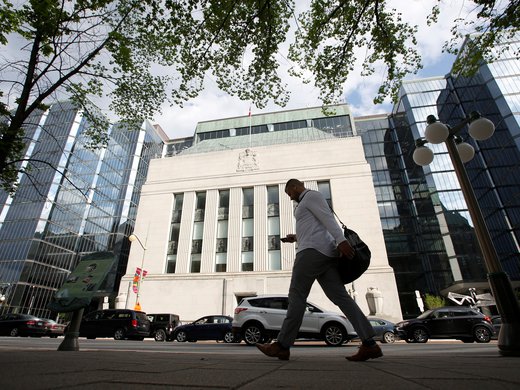In his 1925 essay, “The Economic Consequences of Mr. Churchill,” John Maynard Keynes presciently warned that Winston Churchill's decision, as the United Kingdom’s chancellor of the exchequer, to return the pound to gold at its pre-World War I par value would have a devastating effect on the UK economy. At the time, the gold standard was widely viewed as a litmus test of financial probity and sound policy. The problem was that, while inflation soared between the suspension of the gold standard at the onset of hostilities in 1914 and Churchill's postwar return to international financial orthodoxy, prices increased at different rates across countries. The UK price level tripled. In the United States, which had remained on the gold standard and had accumulated gold that drained from European reserves during the war, prices doubled.
To return to gold at the pre-war par value entailed a painful process of deflation — in effect, the same process that euro-zone officials euphemistically refer to as “internal adjustment.” But, to get the deflation needed to return to gold, nominal wages had to fall. The United Kingdom first had to endure high real interest rates that crippled British manufacturing and led to a prolonged period of unemployment. Moreover, by this time, the United States was a key force in international trade and finance; inflationary pressures in the Roaring Twenties required the Fed to raise interest rates. Keynes recognized that locking in a large real appreciation by returning to gold at the pre-war par value would force additional adjustment on the United Kingdom and make it impossible to alleviate unemployment. Rather than force wages to adjust to the pre-war gold par, Keynes argued the heretical position that the exchange rate should adjust to prevailing wage differentials.
Churchill was not oblivious to these potential effects, drawing as he did on a cross section of advisers, including Keynes, some supporting and others cautioning against the decision to return to gold at the pre-war par value. He laboured over his decision, hesitating, but ultimately choosing orthodoxy over heterodoxy. The high rate of unemployment, which did not fall below 10 percent until 1940, led to a fraying of the social fabric and a polarization of politics.
Why, then, would he do such a thing?
The record shows that Churchill balanced the potential short-term costs associated with deflation against the perceived long-term benefit of maintaining policy credibility through adherence to the strictures of the gold standard. In so doing, he may have underestimated the impact of postwar inflation. (France also subsequently returned the franc to gold, although at a depreciated rate relative to its pre-war par value.) At the same time, intensely proud of the United Kingdom’s imperial past, Churchill was motivated by the desire to restore the influence lost to the United States. In other words, he hoped to preserve the United Kingdom’s pre-war dominance in global finance, thereby keeping the “great” in Great Britain.
Now, no sensible observer would confuse Donald Trump — the putative disruptor-in-chief — of slavish adherence to prevailing orthodoxy. No president-elect in recent history flouted conventional wisdom quite like Trump. Nor is there clarity with respect to the policies he will adopt. As Barry Eichengreen has noted, there is simply too much uncertainty surrounding policy priorities. It is exceedingly difficult, therefore, to evaluate the likely effects of a Trump administration. Nevertheless, there may be parallels between Churchill's decision to return to gold and Trump’s populist vow to “make America great again.”
Most important, perhaps, is the context in which prospective policy initiatives are undertaken. In some respects, the United States is in the position of the United Kingdom a century ago — its dominance in global economic and financial affairs waning owing to factors largely outside its control. Just as the decline in the UK’s relative position was driven by underlying population growth and technological innovation in the US in the late nineteenth and early twentieth centuries, China's growing economic importance reflects the effects of reforms, launched almost four decades ago, and the effects of conditional convergence — the process by which countries with low capital-labour ratios (and lower incomes) tend to grow faster than richer countries with high capital-labour ratios. And, just as World War I both hastened the decline in the UK’s role in global finance and masked the underlying forces at work, so too the global financial crisis accelerated the perceived decline in US economic dominance.
The risk is policy responses that misdiagnose the factors at play and, rather than alleviate, exacerbate the problem. Churchill's decision to return to gold at the pre-war par value, for example, while consistent with prevailing orthodoxy, equated Britain's pre-war economic and financial dominance with the gold standard rather than the innovation and technological head start it enjoyed as the workshop of the Industrial Revolution. “If the British Empire was great under the gold standard,” so the logic went, “it must be that a return to gold is a necessary precondition to regain its prominence.” Similarly, a Trump administration that fails to correctly assess and understand the challenges facing the United States may adopt palliatives that harm American workers over time, however good their short-term effects may be.
Trade per se is not the problem. Moreover, Chinese currency undervaluation might have been an issue a decade ago; as a coterie of commentators have noted, it is not an issue today. In this respect, policies targeted at “correcting” trade to protect American jobs are unlikely to work as intended. Under flexible exchange rates, for example, protectionist measures that increase US net exports (exports less imports) would likely lead to an appreciation of the dollar that partially offsets the effects of trade restrictions on output and employment. At the same time, the benefits from trade could be reduced to all consumers, while the adoption of protectionist measures would likely induce trade retaliation.
The real problem is that for too long economists have extolled the benefits of trade in generating income gains without regard to how those gains are distributed. Some (the highly skilled) have benefited. Others (poorly educated and without skills) have suffered; in this regard, the stagnation of the real wages of low-skilled workers over the past 30 years belies the sunny promises of benefits to all. This has not always been the case: real wages across skill levels increased through successive trade liberalization agreements under the General Agreement on Tariffs and Trade in the post-World War II years. Today, however, policies to assist those adversely affected by the global forces of increased integration, such as increased assistance to workers for retraining (and education for their children) and better health care for their families, may be less of a priority.
The global financial crisis and Great Recession (or, as Brad DeLong would have it, “Lesser Depression”) worsened the plight of those left behind by globalization. This is because of the conscious, politically motivated decision to block or limit policies that would have restored full employment in timely fashion. Only now, more than eight years after the onset of the global financial crisis, is the US economy back at or near full employment. As Paul Krugman has observed, the prospective policies of the Trump administration — raising aggregate demand through infrastructure investment, for example — are precisely those that would have been so beneficial in the depths of the recession. Such policies would mirror the Keynesian stimulus of the Ronald Reagan administration.
Here, too, the danger is misreading the lessons of history. Reagan’s Keynesian tax cuts and exploding deficits came at a time when the US economy was mired in the recession. With unemployment above the full employment level and ample slack in the US economy, massive tax cuts, which ballooned the deficit, were effective in restoring “morning in America.” But over time, as the economy moved to full employment, the threat of inflation would return, creating the risk that continued fiscal expansion would be offset by monetary tightening. Paul Volcker, the Fed chairman who had successfully crushed inflation and wrung inflationary expectations from the economy, would not knowingly temporize with a repetition of the inflation of the 1970s, nor could he be pressured into doing so. Acknowledging the disastrous effects of high interest rates on Jimmy Carter's re-election bid, Reagan agreed to raise taxes to bring fiscal deficits down and forestall monetary tightening.
Were Trump to follow through on a Reagan-type macroeconomic program, thinking that, like his Republican predecessor, it would restore "morning in America" (aka “make America great again”), the results could be somewhat different. With the economy at or near full employment, the Fed has signalled its intention to normalize interest rates from their crisis-induced lows. A significant aggregate demand shock delivered through large tax cuts and deficit spending (recall that many Republican lawmakers have an atavistic aversion to any tax increases) could force the Fed to adopt a more aggressive stance of tightening.
What would be the effects of expansionary fiscal policy and restrictive monetary policy? Well, the much-maligned but insightful Keynesian IS-LM model would predict a significant nominal (and real) appreciation of the dollar. That was, in fact, the case in the Reagan years. But that appreciation would likely lead to an equally significant deterioration in the US current account as exports decline and imports increase. Here's the rub: to the extent that displaced workers in the traded goods sector are absorbed into the non-traded sector (infrastructure investment), the net effect on employment may be positive. Yet, overcoming the frictions that prevent the timely reallocation of labour requires training and health-care coverage, as workers lose the coverage provided by former employers.
It is possible, however, that a Trump administration would attempt to convince the Fed to refrain from pre-emptive tightening or appoint individuals more pliant to administration requests. The argument might be made, for example, that inflation is not a threat given the increased dynamism that other policies are introducing to the economy. The problem here is that increased protectionism would reduce foreign competition and could well reduce the dynamism that has characterized the US economy.
At the same time, the ability of the US to run large current account deficits is dependent on foreigners’ willingness to hold US debt. Since World War II, this has not been questioned. Indeed, in times of global uncertainty foreign investors rush to the safe haven of the US dollar. This confidence in the dollar reflects not just the size of the US economy, which generates scale economies supporting the use of the dollar in international transactions, but also the principles on which the US was founded — a society of laws in which independent institutions uphold and enforce the rule of law and provide the stability necessary for long-term prosperity.
International confidence in these broad principles has been an article of faith for the past 70 years.
And these principles have formed the foundations of American leadership around the globe.
As an independent, technocratic central bank, the Fed has been a key element in the constellation of institutions supporting international confidence in the dollar for much of this time. Efforts to undermine this independence could therefore have unanticipated consequences that extend far beyond the short-term effort to manage aggregate demand. Most important of these possible effects would be questioning of the long-term role of the dollar as international reserve asset and vehicle currency for international transactions. Because the foreign liabilities of the United States are denominated in dollars, an exchange rate depreciation does not have the same effects that other countries experience; meanwhile, the earnings on its foreign assets rise.
This effect, or “exorbitant privilege,” has given the United States an unrivalled capacity to run current account deficits. This capacity might be eroded, however, if foreigners lose faith in the underlying institutions supporting the US economy. In this event, as inconceivable as it may seem, US exceptionalism could be undermined, and with it the capacity to project power and influence around the globe. Rather than restoring greatness to America — the wellspring of which are the ideals on which it is based — populist policies could hasten transition to the ranks of other countries. This would have profound consequences not just for the United States but for the rest of the world as well. As Martin Wolf recently argued: “By succumbing to the lure of false solutions, born of disillusion and rage, the West might even destroy the intellectual and institutional pillars on which the postwar global economic and political order has rested.”
Further reading in this series: Present at the Destruction?; Trump is a Black Swan



